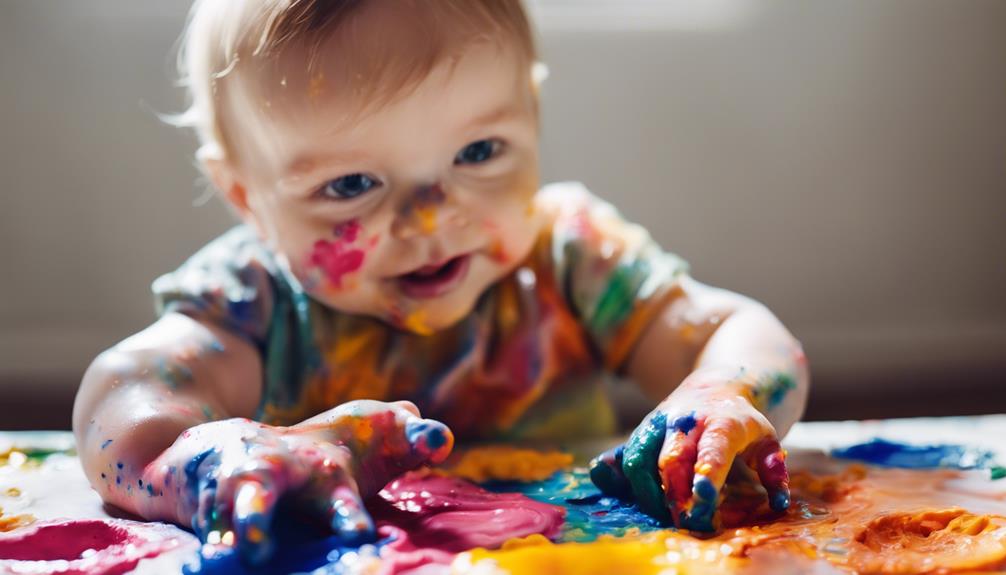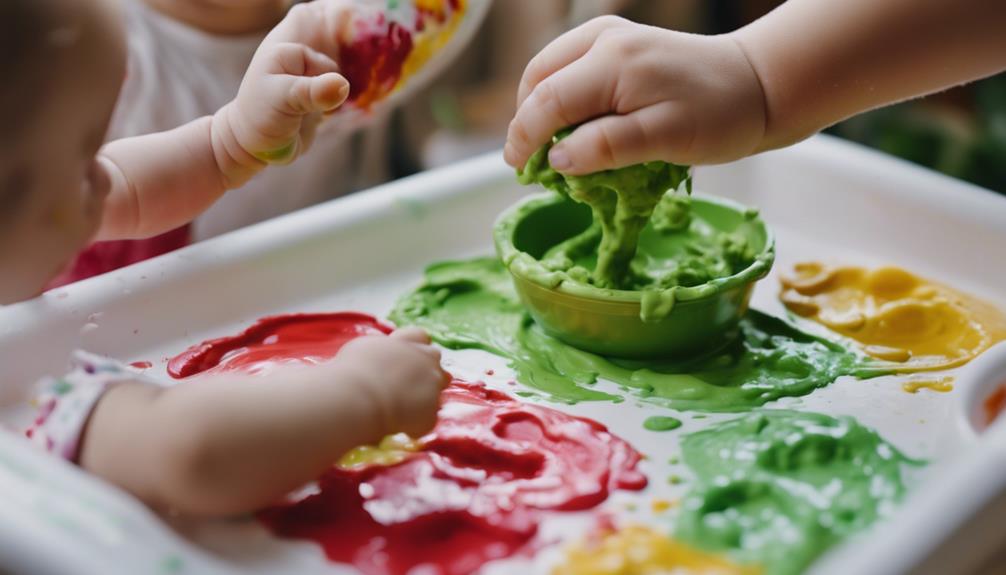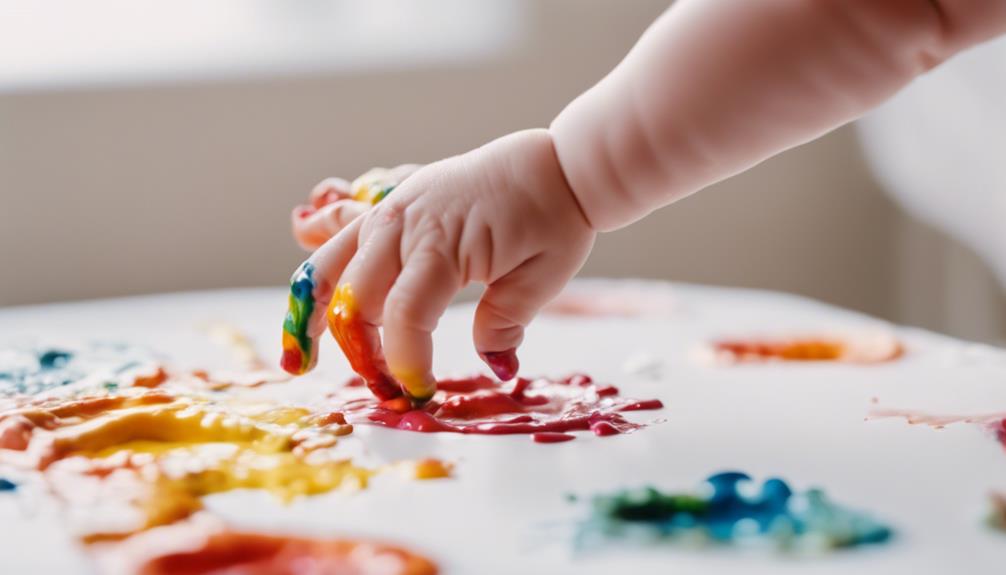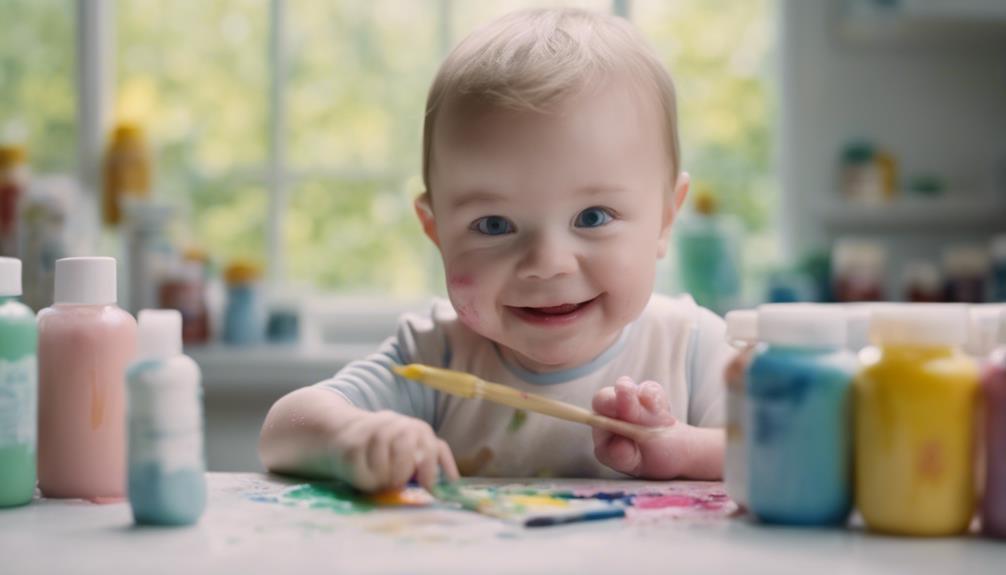Awaken your baby’s artistic potential with safe and thrilling finger painting fun! Make baby-safe finger paint by combining yogurt and food coloring for a creative and secure activity. This edible paint ensures a worry-free artistic experience that stimulates your baby’s senses and cognitive growth. Promote color exploration and fine motor skills with this tactile painting adventure that is both economical and simple to create. Engage your little one in a sensory-rich journey while fostering their love for art. Uncover the advantages of this activity for your baby’s development, and explore various finger painting techniques to boost their creativity. Inspire your baby’s artistic potential with safe and thrilling finger painting fun!
Key Takeaways
- Use edible paint made from yogurt and food coloring for safe and creative play.
- Ensure a mess-free experience by using sealed bags or outdoor painting stations.
- Engage babies in sensory development through tactile finger painting activities.
- Explore various techniques like sponge painting and color mixing for creativity.
- DIY baby-safe finger paint promotes art exploration with non-toxic ingredients.
Safe Edible Paint Recipes for Babies
You can easily create safe and edible paint recipes for babies using common household ingredients. Edible Finger Paint is a fantastic way to introduce your little one to the world of colors and textures without worrying about them ingesting harmful substances.
These Taste Safe recipes often include ingredients like yogurt and food coloring, making them both safe and enjoyable for your baby to explore with their hands and mouths.
Preparing Edible Finger Paint at home not only guarantees the safety of your baby but also provides a cost-effective and fun activity for creative playtime. By following simple recipes and using non-toxic ingredients, you can engage your baby in a sensory experience that stimulates their imagination and cognitive development.
Mess-Free Finger Painting Ideas

For mess-free finger painting ideas, consider utilizing sealed zip lock bags. This method allows your baby to experience the joy of finger painting without the potential for a messy cleanup. Simply pour a small amount of edible finger paint into the bag, seal it tightly, and let your little one squish the paint around with their fingers.
Not only does this keep the mess contained, but it also provides a tactile sensory experience for your baby.
Another way to engage in mess-free finger painting is by taking the activity outdoors. Set up a painting station in your backyard or at a park, and let your baby explore their creativity in a more spacious and easily washable environment.
Additionally, introducing finger painting during tummy time not only encourages motor skill development but also adds a unique twist to the experience. As your baby grows, consider progressing to bathtub finger painting for a fun and easy-to-clean sensory activity.
Sensory Development Through Finger Painting

Engage your child's senses and foster cognitive development through the tactile experience of finger painting. This sensory activity not only allows your little one to express creativity but also supports fine motor skills.
As your child dips their fingers into the colorful paint, they receive sensory feedback that helps them explore various textures and sensations. By engaging in finger painting, children develop proprioception – an understanding of their body's position in space – and enhance spatial awareness through the tactile feedback they receive.
Moreover, sensory play through finger painting can aid in regulating emotions and reducing stress for your child. The immersive experience of finger painting stimulates multiple senses simultaneously, providing a holistic approach to learning and development.
Encouraging your child to partake in this sensory-rich activity can promote cognitive growth and enhance their overall sensory development. So, grab some paint and let your child's fingers create a masterpiece while nurturing their sensory and cognitive skills.
Creative Finger Painting Techniques

Experiment with various tools and textures to explore creative finger painting techniques. Use items like sponges, cotton balls, or brushes to add exciting textures to your artwork.
Incorporating tools such as forks, combs, or toothbrushes allows you to discover unique patterns and designs that will surely captivate little artists.
Try mixing finger paints directly on the paper to teach color theory and blending, enhancing the learning experience through hands-on exploration.
Encourage children to use their fingers to craft shapes, lines, and textures, fostering their creativity and fine motor skills in the process.
For more advanced painting ideas, explore resist techniques using tape, stickers, or stencils to introduce defined shapes into your finger painting masterpieces.
DIY Baby Safe Finger Paint

Discover how easy it's to create DIY baby safe finger paint using non-toxic, edible ingredients that are gentle for your little one's exploration. Making your own finger paint at home allows you to guarantee that the materials are safe for your baby to interact with, promoting a worry-free painting experience.
Here are some benefits of DIY baby safe finger paint:
- Safety: By using non-toxic ingredients, you can rest assured that your baby can freely engage in painting without any harmful effects.
- Cost-Effective: Homemade finger paint recipes are budget-friendly, saving you money while providing a fun and creative activity for your little one.
- Accessibility: The ingredients needed for DIY baby safe finger paint are easy to find in most grocery stores, making it convenient to whip up a batch whenever inspiration strikes.
- Promotes Creativity: Engaging in finger painting activities with your baby stimulates their senses, encourages creativity, and fosters a love for art from a young age.
Exploring Colors With Baby Paint

Introduce your baby to a vibrant world of colors through engaging finger painting activities that stimulate sensory exploration and cognitive development.
By creating simple and safe paint recipes at home, you can provide an exciting activity for your little one to explore various colors in a mess-free way. These activities not only encourage sensory development by allowing babies to touch and feel different colored paints but also promote color recognition and vocabulary development as they name the colors they're using.
As your baby engages in finger painting, they're encouraged to foster creativity and imagination by mixing and experimenting with different colors on their fingers. This hands-on experience not only aids in color exploration but also promotes cognitive development as babies learn cause-and-effect relationships through their interactions with the colors.
Encouraging your little one to explore colors through finger painting isn't only a fun activity but also a valuable learning experience that supports their overall development.
Benefits of Baby Finger Painting

Finger painting with your baby is more than just a messy activity; it plays an essential role in their development. By engaging in this sensory-rich experience, your little one explores different textures, colors, and patterns, stimulating cognitive growth.
As they swirl, smudge, and dab paint on paper, they're enhancing their fine motor skills, setting the stage for future writing abilities.
Sensory Exploration Importance
Enhance your baby's developmental journey through the sensory-rich experience of exploring textures and colors with safe finger paint. Engaging in sensory exploration activities like finger painting offers a multitude of benefits for your little one's growth and development:
- Fine Motor Skills Development: By manipulating the finger paint, babies strengthen the muscles in their hands and fingers, enhancing their dexterity and coordination.
- Texture and Color Awareness: Through the tactile experience of finger painting, babies learn to distinguish between various textures and colors, stimulating their sensory perception.
- Sensory Integration: The sensory feedback from finger painting helps babies integrate information from their surroundings, supporting their overall sensory processing abilities.
- Cognitive Stimulation: Sensory exploration through finger painting can boost cognitive development, creativity, and emotional expression in babies, laying the foundation for future learning and problem-solving skills.
Encouraging your baby to engage in sensory-rich activities like finger painting can have a profound impact on their holistic development.
Cognitive Development Enhancement
Explore how baby finger painting greatly contributes to enhancing cognitive development by fostering creativity, imagination, and cause-and-effect thinking skills. This activity is a great way to engage your little one's mind while having fun.
When your baby dips their tiny fingers into the colorful paints and creates masterpieces on paper, they aren't just making a mess; they're actively learning and growing. Finger painting promotes sensory exploration, which is essential for early learning and emotional development in babies.
Through this hands-on experience, your little artist is also enhancing their color recognition, mixing abilities, and fine motor skills in their fingers, hands, and arms. The kinaesthetic aspect of finger painting supports muscle development in body parts like shoulders, neck, and back.
Additionally, this creative outlet allows babies and toddlers to express their thoughts and emotions, nurturing self-expression and communication skills. So, grab some washable paints and let the artistic journey begin!
Baby Safe Paint Ingredients

To create baby safe finger paint, you can utilize edible ingredients like yogurt or other safe food items. When making your own baby safe paint, keep in mind the following ingredients:
- Yogurt: This creamy base is perfect for creating a smooth texture that's safe for your baby to explore.
- Food Coloring: Adding food coloring allows you to create vibrant and engaging colors for your little one to enjoy during Tummy Time.
- Disposable Cups: Using disposable cups for mixing colors and paint makes cleanup a breeze and adds an element of fun to the squish and mix process.
- Shower Curtain Liner and Old Towels: These items are recommended for easy cleanup after your baby's creative session, ensuring that your space remains tidy and baby-safe.
Baby Finger Paint Safety Tips

Consider using non-toxic and edible finger paint to guarantee the safety of your baby during painting activities. When choosing finger paint for your little one, prioritize products that are labeled as non-toxic and safe for ingestion.
Supervise the painting session closely to make sure your baby from putting painted fingers in their mouth. Remember to keep the painting area tidy and free of any potential hazards that could harm your little artist.
Before and after painting, verify that your baby's hands are clean to prevent any irritations or reactions. Additionally, opt for safe and baby-friendly painting surfaces to create a secure environment for this enjoyable activity.
Frequently Asked Questions
What Does Finger Painting Teach Babies?
Finger painting teaches you about colors, textures, and patterns. It helps you develop fine motor skills by using your fingers. You can express creativity and learn cause-and-effect relationships as you explore different movements and designs, all through hands-on exploration.
How to Make Homemade Baby Safe Paint?
So, you wanna whip up some baby-safe paint, huh? Easy peasy! Just mix cornstarch, water, and food coloring. Voilà! Non-toxic goodness ready for your little Picasso. Get ready for some colorful fun!
What Is the Safe Finger Paint for Babies?
For babies, safe finger paint should be non-toxic and free from harmful chemicals. Look for options with food-grade ingredients like yogurt and natural components such as cornstarch and water. Prioritize safety and creativity!
How to Do Finger Painting Activity?
Imagine finger painting as dancing with colors on a canvas! Set up a safe space, choose baby-safe paint, let your child freely create. Engage together, emphasize colors and textures. Clean up thoroughly after for safety.
Conclusion
To sum up, baby safe finger painting isn't only a fun activity for babies, but it also promotes sensory development and creativity.
By using safe, edible paint recipes and following safety tips, parents can provide a stimulating and engaging experience for their little ones.
So grab some baby-safe paint and let your little artist explore the world of colors and textures with confidence! Remember, a world of creativity awaits at your fingertips.








